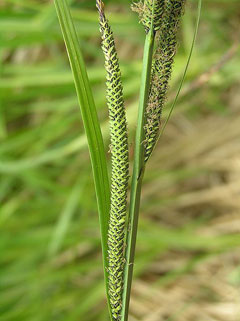 |
|
http://commons.wikimedia.org/wiki/File:Cleaned-Illustration_Carex_elata.jpg |
 |
| http://commons.wikimedia.org/wiki/User:Don_Pedro28 |
Translate this page:
Summary
Bloom Color: Brown, Green.
Main Bloom Time: Early summer, Late spring. Form: Spreading or horizontal, Upright or erect.
Physical Characteristics

 Carex elata is an evergreen Perennial growing to 1.2 m (4ft) by 1.5 m (5ft in) at a medium rate.
Carex elata is an evergreen Perennial growing to 1.2 m (4ft) by 1.5 m (5ft in) at a medium rate.
See above for USDA hardiness. It is hardy to UK zone 7. It is in leaf all year, in flower from May to June, and the seeds ripen from July to August. The species is monoecious (individual flowers are either male or female, but both sexes can be found on the same plant) and is pollinated by Wind.
Suitable for: light (sandy), medium (loamy) and heavy (clay) soils. Suitable pH: mildly acid, neutral and basic (mildly alkaline) soils and can grow in very alkaline soils.
It can grow in semi-shade (light woodland) or no shade. It prefers moist or wet soil.
UK Hardiness Map
US Hardiness Map
Synonyms
C. stricta. Good.
Plant Habitats
Ground Cover; Bog Garden;
Edible Uses
Edible Parts: Root Seed
Edible Uses:
Root - cooked[172]. Seed[172]. No further details are given, but the seed is small and fiddly to use[K].
References More on Edible Uses
Medicinal Uses
Plants For A Future can not take any responsibility for any adverse effects from the use of plants. Always seek advice from a professional before using a plant medicinally.
None known
References More on Medicinal Uses
The Bookshop: Edible Plant Books
Our Latest books on Perennial Plants For Food Forests and Permaculture Gardens in paperback or digital formats.

Edible Tropical Plants
Food Forest Plants for Hotter Conditions: 250+ Plants For Tropical Food Forests & Permaculture Gardens.
More

Edible Temperate Plants
Plants for Your Food Forest: 500 Plants for Temperate Food Forests & Permaculture Gardens.
More

More Books
PFAF have eight books available in paperback and digital formats. Browse the shop for more information.
Shop Now
Other Uses
Bedding
The leaves are used for bedding[61]. Plants form impenetrably dense clumps and when planted close together in drifts make an excellent ground cover[200].
Special Uses
Ground cover
References More on Other Uses
Cultivation details
Landscape Uses:
Border, Foundation, Ground cover, Massing, Specimen. Easily grown in a damp to wet soil in full sun or shade[162, 200]. Members of this genus are rarely if ever troubled by browsing deer[233]. Special Features:Attractive foliage, Wetlands plant, Inconspicuous flowers or blooms.
References Carbon Farming Information and Carbon Sequestration Information
Temperature Converter
Type a value in the Celsius field to convert the value to Fahrenheit:
Fahrenheit:
The PFAF Bookshop
Plants For A Future have a number of books available in paperback and digital form. Book titles include Edible Plants, Edible Perennials, Edible Trees,Edible Shrubs, Woodland Gardening, and Temperate Food Forest Plants. Our new book is Food Forest Plants For Hotter Conditions (Tropical and Sub-Tropical).
Shop Now
Plant Propagation
Seed - sow in situ in the spring in a moist soil in light shade. If seed is in short supply it can be sown in a cold frame and be planted out in the summer. The seed usually germinates in 2 - 6 weeks at 15°c[138]. Division in spring[200]. Very easy, larger clumps can be replanted direct into their permanent positions, though it is best to pot up smaller clumps and grow them on in a cold frame until they are rooting well. Plant them out in the summer or following spring.
Other Names
If available other names are mentioned here
Native Range
TEMPERATE ASIA: Iran, Iraq, Turkey, Armenia, Georgia, Russian Federation-Western Siberia (Western Siberia), Russian Federation (Tyva, Respublika), Kazakhstan, Turkmenistan EUROPE: Denmark, Finland, United Kingdom, Ireland, Norway, Austria, Belgium, Czech Republic, Germany, Hungary, Netherlands, Poland, Slovakia, Russian Federation (European part), Belarus, Estonia, Lithuania, Latvia, Moldova, Russian Federation (Saratov, Volgogradskaja oblast), Ukraine, Bosnia and Herzegovina, Greece, Croatia, Italy (incl. Sicily), Romania, Serbia, Slovenia, Spain, France (incl. Corsica), Portugal AFRICA: Algeria, Morocco
Weed Potential
Right plant wrong place. We are currently updating this section.
Please note that a plant may be invasive in one area but may not in your area so it's worth checking.
Conservation Status
IUCN Red List of Threatened Plants Status :

Growth: S = slow M = medium F = fast. Soil: L = light (sandy) M = medium H = heavy (clay). pH: A = acid N = neutral B = basic (alkaline). Shade: F = full shade S = semi-shade N = no shade. Moisture: D = dry M = Moist We = wet Wa = water.
Now available:
Food Forest Plants for Mediterranean Conditions
350+ Perennial Plants For Mediterranean and Drier Food Forests and Permaculture Gardens.
[Paperback and eBook]
This is the third in Plants For A Future's series of plant guides for food forests tailored to
specific climate zones. Following volumes on temperate and tropical ecosystems, this book focuses
on species suited to Mediterranean conditions—regions with hot, dry summers and cool, wet winters,
often facing the added challenge of climate change.
Read More
Expert comment
Author
All.
Botanical References
17200
Links / References
For a list of references used on this page please go here
Readers comment
© 2010, Plants For A Future. Plants For A Future is a charitable company limited by guarantee, registered in England and Wales. Charity No. 1057719, Company No. 3204567.